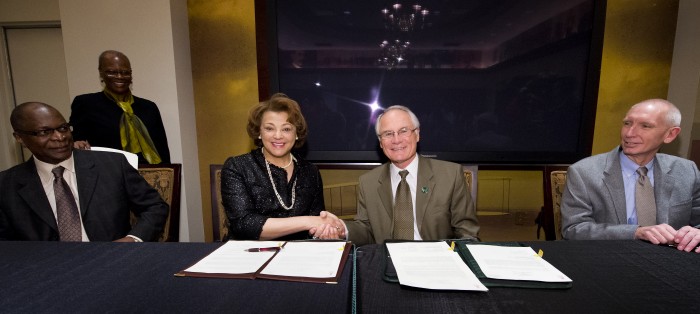
Central State President Cynthia Jackson Hammond and Wright State President David R. Hopkins shake hands after signing a memorandum of understanding that will foster new collaboration between their schools. CSU Interim Provost Patrick R. Liverpool (left) and Wright State Interim Provost Thomas Sudkamp (right) also signed the document.
Wright State University and Central State University have joined forces to create a program that enables Central State undergraduate students to take master’s-level classes at Wright State, allowing students to combine credits from both schools.
At a Jan. 31 public ceremony in Wright State’s Wright Brothers Room, presidents Cynthia Jackson Hammond of Central State and Wright State’s David R. Hopkins signed a memorandum of understanding (MOU) and celebrated the moment.
“This is a new approach to how we combine our capabilities of our respective faculty and programs,” said Hopkins. “This is an inspiring and collaborative step forward for both of our institutions but it’s the students who will reap the most benefit.”
“The distance between Fairborn and Wilberforce is not a great one, but today I feel like the roads are getting shorter and the opportunities for our faculty and students to work together on global issues is greater,” said Hammond. “This is an exciting day.”
The agreement will give students an opportunity to jump-start their master’s degree at Wright State while they finish their bachelor’s at Central State.
The first programs to be used in this collaborative effort will enable Central State students studying in geology and water resources, an Ohio center of excellence, to begin work on a master’s in earth and environmental sciences from Wright State.
“Linking our two universities will create a new path to success for many students, who will benefit from the strong academics of both institutions,” said Hopkins.
Master’s degree courses will be offered for Central State students who qualify for the program. To be admitted, students must have reached senior status at Central State and achieved a cumulative GPA of 3.0 or better. Students must also meet other relevant admissions criteria.
“Central State and Wright State have long been collaborative partners and the linking of undergraduates with graduate programs is a winning combination for students and the two universities,” said Hammond.”
The agreement facilitates cooperation between the two schools while:
- Utilizing the teaching skills of faculty from both universities;
- allowing the development of graduate programs designed for a variety of master’s degrees from both institutions;
- enabling the pursuit of grants and other outside funding for such programs to serve the interests of both universities.

 Milling around
Milling around  Wright State recognizes Nursing Professor Kim Ringo for advancing international student success
Wright State recognizes Nursing Professor Kim Ringo for advancing international student success  Wright State honors graduating students for distinguished doctoral dissertations
Wright State honors graduating students for distinguished doctoral dissertations  Top 10 Newsroom videos of 2025
Top 10 Newsroom videos of 2025  Museum-quality replica of historic Hawthorn Hill donated to Wright State
Museum-quality replica of historic Hawthorn Hill donated to Wright State 